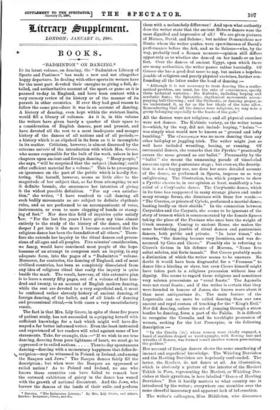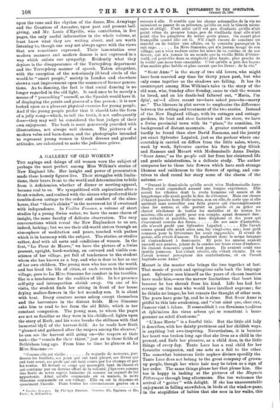4r BOOKS.
"BADMINTON" ON DANCING.*
• Dancing. "The Badminton Library." By Mrs. Lily Grove, and others. Landon: Longmans, Green. and Co.
IN its latest volume, on dancing, the " Badminton Library of Sports and Pastimes " has made a new and not altogether happy departure. In dealing with other sports its writers have for the most part devoted their energies to giving a fall, de- tailed, and authoritative account of the sport or game as it is pursued to-day in England, and have been content with a very cursory review of its history or of the manner of its pursuit in other countries. If ever they had good reason to follow the same procedure it was in an account of dancing. A history of dancing, even kept within the strictest limits, would fill a library of volumes. As it is, in this volume the writers have given barely a quarter of their space to a consideration of English dances, past and present, and have devoted all the rest to a most inadequate and meagre history of the dances of all nations and of all periods,— a history which is as slipshod in its form as it is incomplete in its matter. Criticism, however, is almost disarmed by the extreme naïveté of the introduction with which Mrs. Grove, who seems responsible for the bulk of the work, ushers in her chapters upon ancient and foreign dancing. " Many people," she says, "will be surprised that the subject [dancing] could offer sufficient material for a volume." This is to presuppose an ignorance on the part of the public which is hardly flat- tering. She herself, however, seems so little alive to the magnitude of her subject that, so far from attempting to set it definite bounds, she announces her intention of giving it the widest possible definition. "For my own satisfac- tion," she writes, "I have resolved to call dancing all such bodily movements as are subject to definite rhythmic rules, and as are performed to an accompaniment of voice, instruments, or even to mere clapping of hands or stamp- ing of feet." Nor does this field of inquiries quite satisfy ter. " For the last five years I have given my time almost entirely to the study of the history of the dance, and the deeper I get into it the more I become convinced that the religious dance has been the foundation of all others." There- fore she extends her inquiry to the ritual dances and proces- sions of all ages and all peoples. Five minutes' consideration, we fancy, would have convinced most people of the hope- lessness of an attempt to compress such an inquiry, in any adequate form, into the pages of a "Badminton" volume. Moreover, for centuries, the dancing of England, and of most civilised countries, has been so completely dissociated from any idea of religions ritual that really the inquiry is quite beside the mark. The result, however, of this extensive plan is to leave a scanty fifty pages, out of a volume of four hun- dred and twenty, to an account of English modern dancing, while the rest are devoted to a very superficial and, it must be confessed rather slovenly history of ancient dancing, of foreign dancing, of the ballet, and of all kinds of dancing and processional ritual,—in both cases a very unsatisfactory result.
The fact is that Mrs. Lily Grove, in spite of those five years of patient study, has not succeeded in equipping herself with sufficient knowledge for a task which might well have dis- mayed a far better informed writer. Even the least instructed and experienced of her readers will rebel against some of her statements. Take, for example, this :—" If we wish to see true dancing, dancing from pure lightness of heart, we must go to oppressed or to exiled nations Thus to-day spontaneous dancing—dancing with a momentary happiness that defies de- l., scription—may be witnessed in Poland, in Ireland, and among the Basques and Jews." The Basque dances fairly fill the description ; but when were the Basques an oppressed or exiled nation ? As to Poland and Ireland, no one who knows those countries can have failed to remark how the outward exhibition of gaiety in the dance has waned with the growth of national discontent. And the Jews, who borrow the dances of the lands of their exile, and perform them with a melancholydifference ! And upon what authority does the writer state that the ancient Hebrew dances were the moat dignified and impressive of all P We are given pictures of Miriam, David, and Salome ; but neither Domeniohino nor Dante, whom the writer quotes, were eye-witnesses of David's performance before the Ark, and as to Salome—who, by the way, probably trod a Roman measure—opinion still differs apparently as to whether she danced on her hands or on her feet. Over the dances of ancient Egypt, upon which there are many authorities, the writer passes rather hurriedly. Of Greece she has a good deal more to say, but makes a hopeless jumble of religious and purely physical exercises, further con- founding all the latter under the head of dancing:—
" Although it is not necessary to treat dancing like a mathe- matical problem, one must, for the sake of convenience, specify three technical varieties : the Kubistic, including leaping and acrobatic feats ; the Spheristic, rhythmical movements accom- panying ball-throwing ; and the Orchestic, or dancing proper, as we understand it, as far as the low ideals of the tune allow. Remembering that all the dances were religious, we may note a group belonging especially to the feasts of the gods."
All the dances were not religious ; and all physical exercises were not dances. The Kubistic variety, as the writer terms it—which, by the way, did not include leaping, " halma "- was simply what would now be known as " ground and lofty tumbling." Vhe opaspopoxia was no more dancing than any other ball-play or juggling trick. The writer might just as well have included wrestling, boxing, or running. Of ceremonial dances, she remarks that the Pyrrhic " practically covers the same ground as our ballet." Presumably by the " ballet " she means the unmeaning parade of tinsel-clad amazons upon the pantomime stage ; but even so, the descrip- tion is not a happy one, nor does her more detailed account of the dance, as performed in Sparta, impress us as very enlightening. The illustration, too, which purports to show a Pyrrhic chorus is, in our opinion at least, manifestly a bas- relief of a Corybantic dance. The Corybantic dance, which in its time has reappeared in many strange places and under many strange forms, she dismisses with these few words :— " The Curetes, or priests of Cybele, performed a martial dance, beating loudly on their shields." In the connection between Caryatides and the Caryatis, she seems to be ignorant of the story of treason which is commemorated by the female figures taking the place of the Persians who once bore the weight of Greek masonry. Coming to ancient Rome, she makes the same bewildering jumble of ritual dances and pantomimio dances, both public and private. "In later times," she remarks, "the dancing became very licentious, and was de. nounced by Cato and Cicero." Possibly she is referring to Cicero's dictum in his defence of Murena, "Nemo fere saltat sobrins, nisi forte insanit." But Cicero probably made a distinction of which the writer seems to be unaware. No doubt it would have been disgraceful for a "Freeman" to dance like a hireling or slave, but even Cicero himself might
have taken part in a religious procession without loss of dignity. She seems to regard these religious and sometimes very solemn processions as " rural feasts." The Agonalia were not rural feasts ; and if the writer is certain that they were founded in honour of Janus, she knows more about it than most antiquarians do. The main feature of the Lupercalia can no more be called dancing than our own ancient and royal custom of touching for the " King's Evil." Nor did dancing, unless the act of jumping through a straw bonfire be dancing, form a part of the Palilia. It is difficult to recognise the Cerealia and its torchlight procession of women, seeking for the lost Proserpine, in the following description:— "In the Cerelia [sic], where women were chiefly engaged, a band of maidens draped as wood-nymphs, with flowing hair and wreaths of flowers, was formed round another woman personating the goddess."
Her account of foreign dances shows the same smattering of inexact and superficial knowledge. The Whirling Dervishes and the Howling Dervishes are hopelessly confounded. The latter, the Roufais, do not dance at all. An illustration, which is obviously a picture of the interior of the Mevlevi Tekieh in Pera, representing the Mevlevi, or Whirling Der- vishes at their gyrations, is here labelled "Dance of Howling Dervishes." But it hardly matters to what country one is introduced by the writer ; everywhere one stumbles over the same cheerful inaccuracy and apparent lack of information.
The writer's colleagues, Miss Middleton, who discourses
upon the tune and the rhythm of the dance, Mrs. Armytage and the Countess of Ancaster, upon past and present ball- giving, and Mr. Louis d'Egville, who contributes, in five pages, the only useful information in the whole volume, at least know what they are writing about, and are worth listening to, though one may not always agree with the views that are sometimes expressed. Their lamentation over modern manners and modern dances is not expressed in a way which enlists our sympathy. Evidently what they deplore is the disappearance of the Turveydrop deportment and the Tarveydrop manner of speech. Taken altogether, with the exception of the notoriously ill-bred circle of the would-be " smart people," society in London and elsewhere shows a vast improvement upon the manners of former genera- tions. As to dancing, the fact is that social dancing is no longer regarded in the old light. It used once to be merely a means of " peacocking " oneself, as the Spanish would have it. of displaying the points and graces of a fine person ; it is now looked upon as a pleasant physical exercise for young people. And if the young people prefer that it should take the form of a jolly romp—which, to tell the truth, it not unfrequently does—they may well be considered the best judges of their own enjoyment. The book is most generously provided with illustrations, not always well chosen. The -pictures of a modern valse and barn-dance, and the photographs intended to represent young women in Greek dresses and graceful attitudes, are calculated to make the judicious grieve.



















































 Previous page
Previous page